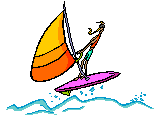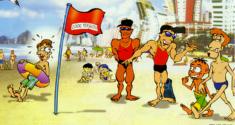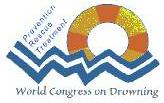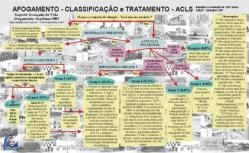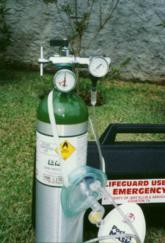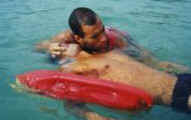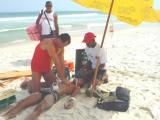| |
|
|
| |
|
|
| |
BIBLIOTECA
O conhecimento é o instrumento mais poderoso na arte de salvar!
Nossa biblioteca é um portal para todas as webs que contenham este
conhecimento.
Contribua nos enviando um assunto e seu endereço na web.
|
|
| |
|
|
| |
|
|
| |
|
|
| |
|
|
| |
|
|
| |
|
|
| |
ASSUNTOS |
|
| |
20 Anos de Grupamento Marítimo do Rio de
Janeiro |
|
| |
A Verdade Sobre os Ataques de Tubarão no Rio
de Janeiro |
|
| |
Acidente com moto-aquática durante campeonato de surf
em Teahupoo |
|
| |
Acqua-Ride - Descendo as Corredeiras |
|
| |
Afogamento - Algoritmo Básico |
|
| |
Afogamento - Algoritmo Avançado |
|
| |
Afogamento - Algoritmo de Ressuscitação
dentro da água |
|
| |
Afogamento New England Journal of Medicine
ano 2012
e
Versão em Portugues - Revista Emergência n 44,
Setembro de 2012
Bibliografia |
|
| |
Afogamento -
Artigo na Revista de Emergência |
|
| |
Afogamento - Classificação em forma de Aula em slides |
|
| |
Afogamento em Brasília |
|
| |
Afogamento - Decúbito lateral (posição lateral de
segurança) |
|
| |
Afogamento - Grau 5 - Uma lição de
profissional |
|
| |
Afogamento
- Aula de Classificação de Afogamento - nível
guarda-vidas |
|
| |
Afogamento - História fantástica |
|
| |
Afogamento - Mortalidade no Brasil e no Mundo
2007 |
|
| |
Afogamento - Uso de Oxigênio |
|
| |
Afogamento - Nova Definição |
|
| |
Afogamento - Nova definição é publicada e aceita pela
OMS |
|
| |
Afogamento para Suporte Avançado de Vida |
|
| |
Afogamento para Suporte Básico de Vida |
|
| |
Afogamento - Trabalhos Brasileiros no
Congresso Mundial da Holanda 2002 |
|
| |
Afogamento - Trabalhos do VI Simpósio Brasileiro de
Salvamento Aquático - Paraná - 2007 |
|
| |
Afogamento - Saiba Como Reconhecer |
|
| |
Afogamento - Resumo de Um Socorro |
|
| |
Afogamento - Medidas de Prevenção - Folder |
|
| |
Afogamento - Recomendações do Congresso
Mundial da Holanda 2002 |
|
| |
Afogamento - Você ajuda a Prevenir1? |
|
| |
Afogamento - Você ajuda a Prevenir2? |
|
| |
Afogamento - Prevenção |
|
| |
Afogamento no Estado de Santa Catarina: Diagnóstico
das mortes ocorridas entre os anos de 1998 e 2008. Ten Cel Onir Mocellin |
|
| |
Água Doce no Planeta Terra - Vai Faltar? |
|
| |
Água-Viva - Queimaduras por Cnidários |
|
| |
AGVERJ - Associação de Guarda-Vidas do Rio de
Janeiro |
|
| |
Alimentos e Banho - Não se misturam? |
|
| |
Anabolizantes - Legal ou Fatal? |
|
| |
Angola - Argentinos ensinam a prevenção de afogamento |
|
| |
Apnéia
- I Torneio AIDA na Rio Boat Show 2004 |
|
| |
Apnéia -
Aprenda
com quem sabe! |
|
| |
Artigo do ACLS Book sobre Afogamento (English) |
|
| |
Artigo - Auto-Salvamento nas Aulas de Natação para
Crianças de 4 a 6 anos
|
|
| |
Artigo -
Cursos de extensão universitária e salvamento aquático
na prevenção do afogamento |
|
| |
Artigo -
Teoria de controle do afogamento |
|
| |
Artigo -
A intervenção do surfista no controle do afogamento |
|
| |
Artigo -
"drowning defintion" |
|
| |
Aspectos Médicos Legais e preventivos dos casos de
Afogamentos na Região de Ribeirão Preto - Dissertação - Rodrigo Thadeu de
Araújo |
|
| |
Aula de Afogamento |
|
| |
Baleias - Pedido pelo fim da caça no dia dos Oceanos |
|
| |
BANDEIRAS - Sinalizações |
|
| |
Banner Institucional Sobrasa |
|
| |
Banner Surf-Salva |
|
| |
Banner Emergências Aquáticas |
|
| |
Biosegurança a guarda-vidas |
|
| |
Botes Australianos |
|
| |
Burnout - Estresse Profissional |
|
| |
Busca Submersa |
|
| |
Campeonato Mundial de Salvamento Aquático na Italia -
2004 |
|
| |
Campeonato Estadual RJ de Salvamento Aquático
- Niterói 2003 |
|
| |
V Campeonato Brasileiro, II Sul-Americano e IV Simpósio Internacional de
Salvamento Aquático Tramandaí - Rio Grande do Sul, Brasil
- 9 a 11 - Dezembro de 2005
|
|
| |
Campeonato de Surf de Peito - Recreio - RJ - 2005 |
|
| |
Campeonato Estadual Paranaense de Salvamento Aquático - 2006
|
|
| |
Carnaval de lágrimas -
Por Sgt Tibiriçá |
|
| |
Certificado Profissional de Guarda-vidas Nacional ou
Internacional |
|
| |
Choque Térmico - Hidrocussão |
|
| |
Código de comunicação |
|
| |
Comer
& Surfar Não se Misturam: Mito ou Verdade?
|
|
| |
Comparação entre Moto
Aquática X Bote Inflável - Cap Smicelato |
|
| |
Como Reconhecer um Afogado |
|
| |
Congresso de Salvamento Aquático Taragona - Espanha
2003 |
|
| |
Congresso de Salvamento Aquático do Mercosul
- Montevidéu - Uruguai |
|
| |
Congresso de Salvamento Aquático
na Venezuela |
|
| |
Congresso de Salvamento Aquático Alicante - Espanha - Set 2005
|
|
| |
Corais - Prazeres e Desprazeres |
|
| |
Crocodilo é resgatado na Praia da Venezuela |
|
| |
Curso Básico de Salvamento Aquático |
|
| |
Curso de Salvamento com Bote Inflável - Bombeiros de
São Paulo (Guarujá) |
|
| |
Curso de Moto-aquática em São Paulo |
|
| |
Curso de Guarda-vidas - Rio
Quente Resort - Goiás (fotos) |
|
| |
Curso Básico de Salvamento - Ceará
|
|
| |
Curso de
Guarda-vidas de Piscina na AFPESP - Prof.
Carlos Smicelato
|
|
| |
Desastre causado pelo furacão Katrina |
|
| |
Dia do Guarda-vidas - Ten Cel Prates |
|
| |
Diferentes tipos de Torres de Salvamento |
|
| |
Disney Suspende Sopa de barbatana de tubarão do
Cardápio |
|
| |
Drowning - How well does a national newspaper
reporting system profile drowning? |
|
| |
Emprego na Área Aquática - Ofertas |
|
| |
Escola - Aula de Primeiros Socorros - Matéria |
|
| |
Esportes Aquático - Prevenção |
|
| |
FARJ - IX
Encontro de Técnicos de Natação |
|
| |
Flutuador - seu uso ("rescue-tube") |
|
| |
Folder BÁSICO sobre prevenção e
afogamento
frente
verso
Completo ZIP |
|
| |
Folder AVANÇADO sobre prevenção e
afogamento
frente
verso
Completo ZIP |
|
| |
Folder de prevenção
do Corpo de Bombeiros do Paraná
INTERNO /
EXTERNO
|
|
| |
Guarda-vidas Brasileiro em Israel |
|
| |
História do dia dos Guarda-vidas |
|
| |
História da Ressuscitação |
|
| |
História do Salvamento Aquático no Brasil |
|
| |
História do Salvamento Aquático no Mundo |
|
| |
Homens São Mamíferos Aquáticos? |
|
| |
Instituto Ecológico Aqualung - Matérias dos
Informativos |
|
| |
Invenção Israelense permite mergulho sem a utilização
das garrafas de ar comprimido |
|
| |
A intervenção do surfista no controle do afogamento |
|
| |
Lei Estadual RJ - Piscinas de uso Público
|
|
| |
Lei Estadual RJ - Prática de Desportos
Aquáticos |
|
| |
Lei Estadual RJ - Legalização de Pedalinhos e
Caiaques |
|
| |
Lei Estadual RJ - Uso de Banana Ski
|
|
| |
Lei Federal de Segurança Aquática em Piscinas, Lagos e
Rios - Ainda não aprovada |
|
| |
Limpeza de Praia - Uma Necessidade Urgente! |
|
| |
Lixo Global Internacional em nossas praias |
|
| |
Luxação Escápulo-umeral |
|
| |
Mergulho - Medicina Hiperbárica |
|
| |
Mergulho
com Crianças - Um Projeto Inovador |
|
| |
Monografia: "O
Serviço de guarda-vidas no litoral Paranaense nas temporadas de 1997 a 2005" |
|
| |
Monografia: Análise do Processo de Qualificação de
Salva-Vidas: Aproximação a Um Modelo Ideal para Santa Catarina. |
|
| |
Mortalidade Infantil - Trabalho da Unicef (dowload) |
|
| |
Mulher Guarda-vidas |
|
| |
Museu do Salvamento - Fotos |
|
| |
Museu das Camisetas
de Salvamento Aquático |
|
| |
Natação - Indicadores Antropométricos |
|
| |
O emprego dos elementos do surf no salvamento aquático |
|
| |
Onda gigantesca atinge navio no Atlântico |
|
| |
Operação Praia Limpa Praia de Gauecá |
|
| |
Oração de
Guarda-vidas
|
|
| |
PDIC - Aula de Salvamento na comemoração de 15 anos |
|
| |
Peixe Bagre tenta engolir uma bola de basquete nos EUA |
|
| |
Pesca de tubarões. Quem são os verdadeiros assassinos
dos mares? |
|
| |
Pingüins - Porque Aparecem em Nossa Costa? |
|
| |
Planeta Terra no ano de 2070 |
|
| |
Postos de Salva-vidas em Salvador
em Recuperação |
|
| |
Praia - Você Realmente Conhece? |
|
| |
Prancha de Resgate (Rescue-Board) |
|
| |
Primeiros Socorros - Introdução |
|
| |
Primeiros Socorros - Sistema de Emergências
Médicas |
|
| |
Primeiros Socorros - Exame Primário |
|
| |
Primeiros Socorros - Exame Secundário |
|
| |
Primeiros Socorros - Manobra de Heimlich |
|
| |
Primeiros Socorros - Posição Lateral de
Segurança |
|
| |
Primeiros Socorros - Emergências Traumáticas
|
|
| |
Primeiros Socorros - Emergências Clínicas
|
|
| |
Primeiros Socorros - Queimaduras |
|
| |
Programa de Qualidade em Segurança Aquática -
Parques Aquáticos e Piscinas |
|
| |
Projeto Botinho
- GMAR - Corpo de Bombeiros do Rio de Janeiro |
|
| |
Qualificação de Um Salva-Vidas (Monografia) |
|
| |
Raios e Tempestades - É seguro Surfar? |
|
| |
Recomendações Internacionais 2005 na Área de
Emergências - AHA e ILCOR
(completo em zip) |
|
| |
Recomendações Internacionais 2005 na Área de
Emergências - AHA e ILCOR
(resumo) |
|
| |
Relação de cursos de
extensão universitária e salvamento aquático na prevenção do afogamento |
|
| |
Relâmpagos |
|
| |
Resgate - Partes Essenciais |
|
| |
Ressuscitação dentro da água - trabalho científico |
|
| |
Ressuscitação
- Consenso Mundial - ILCOR 2005 |
|
| |
Ressuscitação - Consenso Mundial - Trabalhos
Brasileiros |
|
| |
Rio Grande do Sul -
Operação Golfinho
2004/05 da Brigada Militar |
|
| |
Salvamento Aquático - Fotos Históricas |
|
| |
Salvamento
Internacional em Torres - RS |
|
| |
Segredos do Mar |
|
| |
Seres Marinhos Perigosos |
|
| |
Serviço de Salvamento em Cartagena |
|
| |
Sinais de Comunicação da Água-Areia e
Vice-Versa |
|
| |
Sol, o perigo da exposição prolongada |
|
| |
Sonhos e Delírios de um Surfista |
|
| |
Sujeira Aquática - O
que fazer?
- Vídeo de Fabiano Prado Barretto |
|
| |
Surf-Salva1
- Folder (frente) em jpg |
|
| |
Surf-Salva2 - Folder (dorso) em jpg |
|
| |
Surf-Salva
em Guaeca São Sebastião |
|
| |
Surf-Salva em São Vicente-SP |
|
| |
Curso Surf-Salva - Bombeiros de São Paulo
|
|
| |
Surfista salva menino em Niterói |
|
| |
Surf - Você já se machucou? |
|
| |
Surf - Projeto Girls Go Surf |
|
| |
Torres de Salvamento |
|
| |
Tetraplegia - Cuidado! |
|
| |
Tragédia na praia de Bondi - Austrália |
|
| |
Traumatismo Raqui-medular na Água - Veja
também as
Técnicas em vídeo
1 /
2 /
3 |
|
| |
Tubarões - 4 guarda-vidas arriscam a vida
para Salvar uma |
|
| |
Tubarões - Porque o Medo? |
|
| |
Uniforme do Salvamar de São Paulo |
|
| |
Utepas - Treinamento de sobrevivência em queda de
helicóptero |
|
| |
Você Ajuda a Salvar? |
|
| |
Você sabe reconhecer um afogado antes de
entrar na água? |
|
| |
Você tem Medo? |
|
| |
Todos os trabalhos de WWS 2007 - Porto -
Portugal - Congresso Mundial de Salvamento Aquático |
|
| |
|
|
| |
|
|
| |
Trabalhos do Congresso Mundial de
Salvamento Aquático |
|
| |
WWS 2007 - Porto -
Portugal |
|
| |
Day 1 - Thursday, 27 September 2007
|
|
| 1 |
Joost Bierens: World Congress on Drowning (WCD)
2002: Lessons learnt - Research and developments since. |
|
| 2 |
B. Chris Brewster: Overview of ILS actions since WCD 2002 |
|
| 3 |
Douglas B (Pete) Peterson: Pulling on the same oars together—we can make a
difference |
|
| 4 |
Aminur Rahman: The Bangladesh Experience: A Developing Country’s Perspective
on |
|
| 5 |
Peter George (Australia): Total Life Saving Service Plan |
|
| 6 |
Jonathon Webber and Billy Doyle (New Zealand): SENTINEL- A new systematic
approach to the early recognition and classification of in-water behavior
consistent with ‘threat to life’ following concerning results of lifeguard
efficacy research |
|
| 7 |
David Szpilman (Brazil): 12 Years of Brazilian Lifesaving Society (SOBRASA)
– Did we make any difference? |
|
| 8 |
Stathis Avramidis (Greece): Risk Taking Behaviour as a Cause of Drowning
after Engagement in Swimming & Non-Aquatic Activities |
|
| 9 |
Larry Patterson (Canada): Factors affecting lifeguard recognition of the
submerged victim. Implications for lifeguard training, lifeguarding systems
and aquatic facility design |
|
| 10 |
Greg McLennan (Australia): Utilising the Sport of Lifesaving to establish a
“community base” within lifesaving organisations – the essentials, a model,
the process and the benefits |
|
| 11 |
Brett Sullivan (New Zealand): Case Study: ‘Piha Rescue’ – Research
opportunities associated with four years of continuous filming at NZ’s
busiest beach for a hugely successful and high rating reality TV show. What
can be achieved through lifeguarding and |
|
| 12 |
Michael Shane (Canada): Are they watching…the SEE system: Lifeguard-scanning,
inhibitors and enhancement variables and a system that allows supervisory
staff quantifiably evaluate a lifeguard’s supervision performance |
|
| 13 |
Michael Linnan (TASC): SwimSafe-A community-based water safety and
swim-learning program suitable for developing countries |
|
| 14 |
Peter Davis (USA): Public education collaboration: USLA and NOAA (National
Oceanic & Atmospheric Administration) and the National Weather Service, the
Sea Grant Foundation |
|
| 15 |
Bernadette Matthews (Australia): Swimming Pool Injury Data: Improvements to
Lifeguard Training |
|
| 16 |
Justin Scarr (Australia): The role of lifesaving
in community development, experiences from indigenous Australia |
|
| 17 |
Erik Bech (Denmark): RIP Currents - A Public Awareness Negligence |
|
| 18 |
Billy Doyle (New Zealand): Is the efficay of detecting a simulated drowning
patient altered if the person conducting the surveillance is a non-swimmer? |
|
| 19 |
Jonathon Webber (New Zealand): Establishing Coastal Lifeguard Services in
Pakistan |
|
| 20 |
Bernadette Matthews (Australia): Impacts of major water safety campaigns:
Play it Safe by the Water 1997 to 2007 |
|
| 21 |
Steve Beerman (ILS): ILS Position Statement: Seizure Disorders in Lifesaving
and Lifeguarding |
|
| 22 |
Klaus Wilkens (Germany): Financial funds as fundamental basis to develop
lifesaving structures |
|
| 23 |
Richard Ming Kirk Tan (Singapore): Public water safety education through
letters to the newspapers |
|
| 24 |
David Szpilman (Brazil): How Lifeguards would know the severity, treatment
and outcome of drowning on the accident site |
|
| 25 |
Hans van der Pols (Netherlands): Impact of 11 Recommendations of WCD 2002 |
|
| 26 |
Allart Venema (Netherlands): The potential use of an award (honours–medals
or certificates) scheme for drowning rescues to study prevention, rescue and
resuscitation of drowning cases |
|
| 27 |
Francesco (Frank) Pia (USA): What Can Science Teach us about Lifesaving and
Drowning Prevention? |
|
| 28 |
Julie Gilchrist: Estimating the Burden - Nonfatal and Fatal Drowning in
Recreational Water Sites - US 2001-2002 |
|
| |
|
|
| |
Day 2 - Friday, 28 September 2007 |
|
| 29 |
Peter Agnew (ILS): ILS World Drowning Report
|
|
| 30 |
Kidist K. Bartolomeos (World Health Organisation): Global burden of drowning |
|
| 31 |
Seyed Mostafa Agha Mirsalim (Iran): Rescuing Plan for the Caspian Sea Blind
Areas |
|
| 32 |
Diego Abalos Brandon (Argentina): Manoeuvres and Rescue Skills Program and
Rescue with paddleboards and/or Rescue Boards |
|
| 33 |
Joanne Vincenten (European Child Safety Alliance): Reporting of Water Safety
Policy Measures in 17 European Countries to Advance Water Safety and Reduce
Childhood Drowning |
|
| 34 |
Steve Beerman (Canada): Evidence based process - how to do this in
lifesaving |
|
| 35 |
Cliff Nelson (United Kingdom): Principles of Beach Risk Assessment: A UK
perspective |
|
| 36 |
Luiz Morizot-Leite (USA): Risk Management Analysis; when, where and how
Ocean Rescue Lifeguards are suffering occupational injuries |
|
| 37 |
John Pearn (Australia): Safety Legislation: A pillar of Drowning Prevention |
|
| 38 |
Michael Linnan (TASC): The burden of drowning in Asia: prevalance and risk
factors in children |
|
| 39 |
Peter Dawes (United Kingdom): Developing a risk assessment model for
practical application in the UK |
|
| 40 |
John McVan (USA): Normalizing the Abnormal: The Efficacy of Stress Related
Aquatic Instruction and its Correlation to Drowning Prevention in Theatre
Specific Water |
|
| 41 |
Deborah C. Girasek (USA): Are Pregnant Pool
Owners Receptive to Isolation Fencing Installation? |
|
| 42 |
Linda Quan and Elizabeth Bennett (USA): Drowning risk and prevention in
minority communities |
|
| 43 |
Michael Vlasto and Adam Wooler (United Kingdom -RNLI): An integrated
approach to Beach Lifeguarding and Lifeboating |
|
| 44 |
Peter Wernicki (USA): A preliminary report of the US Lifeguard Standards
Coalition - from the American Red Cross, the US Lifesaving Association, and
YMCA of the USA |
|
| 45 |
Steve Beerman (Canada): Evidence based process - how to do this in
lifesaving |
|
| 46 |
Michael Linnan (TASC): Drowning in the developing world: Differences from
drowning in rich countries and prevention implications |
|
| 47 |
Craig Roberts (Australia): Using camera technology to prevent drownings |
|
| 48 |
Jørn Dam (Denmark): Didactical reflections considering the development of
lifesaving competence in physical education students |
|
| 49 |
Teresa Stanley (New Zealand): Do big people really know best about water
safety? An examination of toddler water safety at swim lessons with
particular reference to the perceptions of parents and instructors |
|
| 50 |
Dhaya Sewduth (South Africa): The data related to drowning problem in South
Africa and the implication of this |
|
| 51 |
Daniel Hartmann (Israel): Onshore Storminess Factor (ONSF): A New Tool for
Regional Beach Hazard Rating (RBHR) and Beach Safety Management (BSM) |
|
| 52 |
Perry Smith (Canada) and Janet Castro (United Kingdom): Simulated Emergency
Response Training Program |
|
| 53 |
John Pearn (Australia): Bathtub Drowning Deaths. New Twists on an old
problem |
|
| 54 |
John Connolly (Ireland): Suicide by Drowning: Exclusion of such deaths from
official drowning statistics |
|
| 55 |
Peter Agnew (Australia): Australian Public Coastal Safety Guidelines |
|
| 56 |
Detlev Mohr (Germany): Main Skills for Lifesaving and How to Train these
Skills: Bettering the Quality of Lifesaving Services |
|
| 57 |
Deborah C. Girasek (USA): Are Pregnant Pool
Owners Trained in Infant/Child Cardiopulmonary Resucitation? |
|
| 58 |
Ludger Shulte-Hulsmann (Germany): Drowning statistics on the basis of press
cuttings |
|
| 59 |
Steve Wills (United Kingdom): The research, development and implementation
of the UK national guidelines and specifications for coastal public rescue
equipment |
|
| 60 |
Kelly Fischbein (USA): Skill Retention in Lifesaving: A Review of Literature
and a Look to the Future |
|
| 61 |
Robert Stallman (Norway): The Teaching of Swimming Based on a Model of the
Causes of Drowning |
|
| 62 |
Peter Barss (United Arab Emirates): A Practical
Approach to Identifying and Counting Cold-water Immersion Deaths, and
Assessing Associated Activities and Risk Factors |
|
| 63 |
Jim Howe and Ralph Goto (USA): State of Hawaii Beach Hazard Information
Website oceansafety.soest.hawaii.edu |
|
| 64 |
Jana Novotna (Czech Republic): Comparative Analysis of Educational
Programmes (A Proposal of Innovation of Water Safety Educational Programme
of Czech Red Cross in relation to the Standards of International Lifesaving
Federation) |
|
| 65 |
Barbara Byers (Canada): Swim to Survive Dhaya Sewduth (South Africa): The
impact of the absence of legislation governing water safety and drowning
prevention |
|
| 66 |
Julie Evans (Australia): Dangerous waves - long period waves: Surf Alerts |
|
| 67 |
Norman Farmer (Australia): International Water Safety and Lifesaving
Education by ILS |
|
| 68 |
Dirk Bissinger (Germany): Electronically devices and teaching software as
instruments of modern education in lifesaving |
|
| 69 |
Michael Shane (Canada): Aquatic Facilities - Total Life Saving Service Plan
|
|
| 70 |
Anthony Handley (United Kingdom): Do automated external defibrillators have
a place in lifeguarding / lifesaving? |
|
| 71 |
Lorraine Wilson-Saliba (Canada): Swim for Life - A new, innovative approach
to swim program design and drowning prevention |
|
| 72 |
Guy Thomas (DAN Europe): Factors associated with
open-circuit recretaional diving fatalities |
|
| 73 |
Joost Bierens (Netherlands): The same result for less money? - Is training
in the use of the automated external defibrillator (AED) is equally
effective with poster self training as with instructor based training |
|
| 74 |
Matt Claridge (New Zealand): Swim For Life – A Mass Media Campaign Promoting
Learn to Swim |
|
| 75 |
Peter Chennell (UK): How safe is recreational boating in the UK? |
|
| 76 |
Anthony Handley (United Kingdom): Self instruction in basic life support –
is this the answer to the problem of poor training?
|
|
| 77 |
Klaus Wilkens (Germany): Campaign against the drowning of children
|
|
| 78 |
Malcolm Poole and Stan Konstantaras (Australia): Rock Fishers’ Practices and
Perception of Rock Fishing Water Safety |
|
| 79 |
Joost Bierens (Netherlands): Are there any
different in retention of BLS and AED skills between younger (15-22 years)
and older (>35 years) lifeguards? |
|
| 80 |
Peter Barss (United Arab Emirates): Knowledge of
swimming pool safety among vendors and home pool owners and provision of
safety devices and information by vendors in United Arab Emirates |
|
| 81 |
Kevin Moran (New Zealand): Rock fishers’ practices and perception of rock
fishing water safety |
|
| 82 |
Ricardo dos Santos Nunes (Brazil): THE DOLPHIN PROJECT – Since 1964, the
largest drowning prevention project in Brazil – 150.000 children trained |
|
| |
|
|
| |
Day 3 - Saturday, 29 September 2007 |
|
| 83 |
David Szpilman (Brazil): International Life Saving Federation ILS: How and
what were the impacts on Brazil Lifesaving (SOBRASA)
|
|
| 84 |
Fernando Martinho (Portugal): “CPLP” – a new
space for coo- peration within ILS: AsNaSA Portugal’s proposal of an Action
Plan for Teaching and Training in Water Safety Quality in the Portuguese
Speaking Countries |
|
| 85 |
Daniel Hartmann (Israel): Water Safety
Management – Morphodynamic and Human Parameters from the Israeli
Mediterranean Coast – Parame- trization for a Fault Tree Analysis (FTA) |
|
| 86 |
Angela Lawson (New Zealand - ILS): The Dr Ian Mackie Fellowship -
Facilitating Youth Involvement in Lifesaving
|
|
| 87 |
Ricardo Nunes (Portugal): Professional Water
Life Saver Course – Level II: a course certified by official Portuguese and
European Union Standards |
|
| 88 |
Joost Bierens (Netherlands): Moderate sea states do not influence the
application of an automated external defibrillator (AED) in rigid inflatable
rescue boats |
|
| 89 |
Chris Giles (Australia): Developing our youth - securing our future |
|
| 90 |
Sandra Nascimento (Portugal): Child and
adolescent drowning in Portugal |
|
| 91 |
Bo Løfgren (Denmark): How to choose an automated external defibrillator (AED)
for the aquatic environment – review of selection considerations |
|
| 92 |
Katrin (joe) Ripcke (Germany): Youth work/welfare
as a task of lifesaving organisations |
|
| 93 |
Arturo Abraldes (Spain): Evaluation of risk factors on beaches |
|
| 94 |
Leornado Manino (Argentina): Spinal Cord Immobilization in Aquatic
Environment
in spanish |
|
| 95 |
David Szpilman (Brazil): Junior and volunteer lifeguard – A new concept to
help the professional on duty |
|
| 96 |
Osni Pinto Guaiano (Brazil): Global Heating and
Mortality for Drowning: How a project for children and adoloescent in
fundamental and medium teaching in the SOROCABA CITY can contribute to
preserving the environment and prevent drowning in Brazil |
|
| 97 |
Anthony Handley (UK): Resuscitation Guidelines 2005 – what’s new and why?
John Fitzgerald (Australia): Leadership development within a water safety
organisation |
|
| 98 |
John Fitzgerald (Australia): Leadership development within a water safety
organisation |
|
| 99 |
Peter George (Australia): Is it possible to achieve an international
standard for beach safety flags? |
|
| 100 |
Armindo Carvalho (Portugal): Maritime Safety and Risks Prevention in the
European Atlantic Coast: Challenges for a Transnational Cooperation
Framework |
|
| 101 |
David Szpilman (Brazil): In-water resuscitiation: What are the highlights
and pitfalls? |
|
| 102 |
Steve Wills (United Kingdom): The development and implementation of two
national beach safety signage standards (UK & Australia) and how they are
leading to the creation of an international beach signage standard |
|
| 103 |
Jorge Dias (Cabo Verde): AsNaSA Cabo Verde –
National Water Safety Association: a new life saving organization in ILS
Network and the Professional Training and Employment System of Cabo Verde
|
|
| 104 |
Jonathon L. Epstein (USA): Evidence Based First Aid Guidelines-Report of the
US National First Aid Science Advisory Board |
|
| 105 |
Dias Martins (Portugal): ISN - Instituto de
Socorros a Naufragos: Past, Present and Future |
|
| 106 |
Tara Reilly (United Kingdom): Occupational fitness standards for beach
lifeguards |
|
| 107 |
Justin Scarr (Australia): Water Safety for Culturally and Linguistically
Diverse Communities:“Swim for Life” Muslim Aquatic Safety and Recreation
Program |
|
| 108 |
Nuno Pinto (Portugal) Professional aquatic
security and rescue technician course |
|
| 109 |
Carl Martinez (USA): Fitness Standards for Lifeguards: The Surf Lifeguard
Pre-Employment Test |
|
| 110 |
Mark Haimona (New Zealand): Drownbase - Identify
atrisk factors for Maori Drowning in New Zealand |
|
| 111 |
Osni Pinto Guaiano (Brazil): Professional and Education Updating: Is it
possible to increase the measures of prevention and to reduce the mortality
for drowning in the State of SÃO PAULO? |
|
| 112 |
Arthur Clarke (USA): Eye health and vision standards for lifeguards
|
|
| 113 |
John Fitzgerald and Chris Giles (Australia): Embracing cultural diversity
within Surf Life Saving Australia |
|
| 114 |
José Festas (Portugal): “Pro-More Security for
Sea Men” Association - a pilot project providing recycling training for
improving sea fishermen security (2007-2013) |
|
| 115 |
Michael Tipton (United Kingdom RNLI): Visual acuity standards for Beach
Lifeguards |
|
| 116 |
Mário Costa (Portugal): Education and training on the Portuguese legislation
for Water Safety Quality Standards: Notes to improve Law 44/2004, in
conformity with the “Portaria 1311/2006” |
|
| 117 |
Daniel Hartmann (Israel): Water Safety
Management - Ergonomic approach to study lifeguards Effectiveness and
Vigilance |
|
| 118 |
Paul Hayden (United Kingdom): Management of
Major Flood Events - FRS Contribution to the Emergency Phase |
|
| 119 |
Bob Clark (Canada): Drowning incident analysis |
|
| 120 |
Alexadre Tadeia (Portugal): Operational Strategy
of Portuguese Lifeguards Associations in order to prevent drowning |
|
| 121 |
Romeu Bruno (Brazil): Jet ski rescue |
|
| 122 |
Bob Albers and Sergeant Darrell (USA): The importance of a lifeguard
response to water related natural disasters |
|
| 123 |
Fernando Martinho (Portugal): AsNaSA - First
Portuguese Life Saving Association - 30 years in lifesaving voluntary work -
education and tranning |
|
| 124 |
John Connolly (Ireland): Rescues by Irish Police Officers |
|
| 125 |
Zaid Chelvaraz (Malaysia): Role of lifesavers in
water related natural disasters |
|
| 126 |
Conference Wrap Up and Plenary Address - Steve Beerman (ILS and WWS 2007
Scientific Committee): Summary of Workshop Recommendations |
|
| |
|
|
| |
POSTER PRESENTATIONS |
|
| 127 |
Trauma In Brazil – 126,000 deaths in 2003 - Do we know enough to prevent? -
David Szpilman, Brazil |
|
| 128 |
Drowning In Brazil – 179,000 deaths in 25 Years - Are we stepping down? -
David Szpilman, Brazil |
|
| 129 |
Basic water life support (BWLS) – Reevaluation after 232 courses. - David
Szpilman, Brazil |
|
| 130 |
Aeromedical rescue helicopter – How it works on Drowning? - David Szpilman,
Brazil |
|
| 131 |
Certifications qualify water safety program – Do the Benefits overcome Costs?
- David Szpilman, Brazil |
|
| 132 |
Surfer-Save – A way to decrease drowning by teaching lifesaving to surfers -
David Szpilman, Brazil |
|
| 133 |
Do we prepare lifeguards to face death or just to be heroes? - David
Szpilman, Brazil |
|
| 134 |
A tale of two Park Agencies: The role of local and regional government
agencies in drowning prevention.- Linda Quan & Elizabeth Bennett, USA |
|
| 135 |
Understanding older persons water safety needs – research and development. -
Justin Scarr for Richard Franklin, Australia |
|
| 136 |
Surf Education - Clubs and Schools. - John Fitzgerald, Australia |
|
| 137 |
Kia Maanu, Kia Ora – Stay Afloat, Stay Alive - A Water Safety Strategy for
Māori in Aotearoa. - Mark Haimona, New Zealand |
|
| 138 |
Fitness Requirements for Beach Lifeguards to operate Rescue Watercraft and
Inshore Rescue Boats. - Tara Reilly, United Kingdom |
|
| 139 |
“Bridging the Gap” – 12,000 km of coastline coverage. - Chris Peck,
Australia |
|
| 140 |
The role of Physical Education Teachers in the
prevention and reduction of accidents and deaths by drowning. - Osni Pinto
Guaiano, Brazil |
|
| 141 |
Prevention of Drowning: Are we, professional lifeguards, ready to educate
the population or are we prepared exclusively to perform rescues? - Osni
Pinto Guaiano, Brazil |
|
| 142 |
Maximise rescuer safety and effectiveness through pre-rescue communication.
- Brendan Donohoe, Ireland |
|
| 143 |
Water Safety Education Methods and Statistics of the Ocean City, Marlyand
Beach Patrol. - Mark W. Muller, USA |
|
| 144 |
A National Lifesaving Plan to prevent drowning and injury in New Zealand,
2005-2010: Rolling out the strategy. - Brett Sullivan, New Zealand (FSP) |
|
| 145 |
The Integrated Aquatic Programme (IAP): A collaborative and sector wide
approach to developing a ‘Roadmap’ for water safety education in NZ - Brett
Sullivan, New Zealand (FSP) |
|
| 146 |
The prototype of situational dimensions in water lifesaving. - Tomasz
Zalewski, Poland |
|
| 147 |
How does the educational standards change in the
case of pupils at grammar-schools after a preventive campaign “A Blue Patrol”?
- Tomasz Zalewski, Poland |
|
| 148 |
A proposed framework for developing a plan for research in life saving and
water safety. - Robert Stallman, Norway |
|
| 149 |
Swim for Life - A new, innovative approach to swim program design and
drowning prevention. - Lorraine Wilson-Saliba, Canada |
|
| 150 |
Angel Ring - Rock Fishing Safety. - Stan Konstantaras, Australia |
|
| 151 |
Safety in Public Aquatic Centres: Lifeguards are not Babysitters! - Justin
Scarr for Caitlin Chellew, Australia |
|
| 152 |
Cartoon Drowning Prevention Video – A way to reach children in 8 minutes. -
TRABALHO PREMIADO - Jorge Cerqueira & David Szpilman, Brazil |
|
| 153 |
Didactical reflections considering the development of lifesaving competence
in physical education students. - Jørn Dam, Denmark |
|
| 154 |
Predicting lifeguard’s ability to succeed in
real lifesaving situations. - Michael Iwersen, Denmark |
|
| 155 |
IT strategy – a didactic challenge in the learning process of lifesaving
skills.- Lillan Madsen, Denmark |
|
| 156 |
Collection of captured sharks off Recife - Brazil at local Lifeguard Group.-
André de Souza Ferraz Alves, Brazil |
|
| 157 |
The Story of the Inflatable Rescue Boat (IRB). - Edward Wake-Walker and
Warren Mitchell, UK |
|
| 158 |
Water Safety Campaign. - Sandra Nascimento,
Portugal |
|
| |
|
|
| |
|
|
| |
Trabalhos Brasileiros publicados na Conferencia Mundial de
Afogamento no Vietnam 2011 |
|
| |
|
|
| |
|
|
| |
|
|
| |
|
|
| |
|
|
| |
|
|
